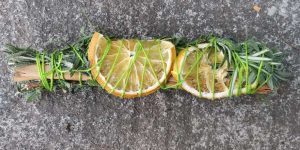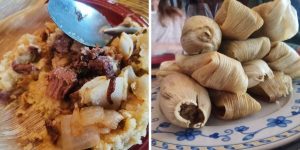Double Dig
Double digging is where you dig a 12 in trench, setting the top soil to the side. Then you till another 12 inches deeper into the trench, loosening the soils so roots can easily grow and nutrients can easily flow. You then start a second trench, do the same thing, and move the top soil from one trench to the next. Then in subsequent years you do deep tilling with compost, which is being demonstrated by Jill and Don of Raven Rocks Eco Village in the following video:
Jill is using a u-bar, a tool that was developed in France and is included in a type of plant cultivation called, French Intensive Gardening. This style of gardening was developed in the last 1800’s just outside of Paris – 18 inches of horse manure we applied to the garden and the seeds were planted so close that the leaves of the adult plants could touch. It worked, and the method began to spread.

Companion Planting
Companion planting is an important part of biointensive gardening. Some plants actually like each other, while other plants don’t. If your desire is a high yielding garden, it is in your interest to learn what plants help each other. A very common companion planting tri is called the Three Sisters – corns, bean and squash. Beans bring nitrogen to the soil and climb the corn. The squash provides ground cover that shades out weeds. And the corn provide a stalk for the beans to grow.
We have a viral article about companion planting that you can find here:
My favorite companions are tomatoes and basil, rose and garlic, & strawberries and onion.
Composting
Compost is food for your plants! Its one of the most important aspects of gardening. It is simply decomposed matter, full of nutrients and microbes that will help your plants grow. There is an art to creating good compost and we have several article about how to do it right:
- This is why your compost stinks
- IT’S ALIVE! Living No-Turn Compost: BioChar
- Why you should use a composting toilet
You cannot do biointensive gardening without compost – its the fuel for your farm and and a necessary component. This style of gardening uses mostly plant matter compost, but it can also include animal compost if its properly prepared. Horse manure is the only animal compost we suggest you add directly to soil, as its mostly plant matter! Other manure is too hot and needs to compost for at least a season before you add it to your soil.
Eight Key Principles of Biointensive Gardening (from hgtv):
1: Deep soil preparation. “Loosening the soil down to 24 inches sounds like a lot of work,” Drewno says, “but you can do it in a way that’s invigorating. Typical agriculture only goes 6 to 8 inches deep. That’s where the soil life is, and it gets destroyed when you plow deeply (and use chemicals and fertilizers). In the biointensive system, double digging is a form of conservation tillage that produces higher yields.” It also encourages deeper soil life, root development and water retention, and encourages nutrient cycling (the ways in which nutrients move from the physical environment into living organisms, and are then returned back to the environment.) 2: Close plant spacing. Rather than planting in rows, biointensive growers plant in hexagonal shapes, “the most efficient form to pack things in, in nature,” Drewno explains. Hexagons are the shape of water crystals. Bees use the hexagon in honeycombs. When the soil is prepared deeply, and plants are spaced close together, roots can grow deeper. That helps increase yields from two to six times the yields from conventional agriculture. 3: Composting. Instead of heaping compost in distant piles, biointensive growers pile materials in their gardens. “Nutrients naturally leach out directly into the growing beds, not into some marginal space,” Drewno says. “We try to use a cold composting technique. The compost (material) takes longer to cure, but it becomes more diverse, and produces more compost out. Hot piles consume organic matter fast, as microbes release carbon into the atmosphere.” Instead of bringing in outside manures, biointensive gardeners “focus on growing our own compost, and devote at least 60 percent of our growing area to dual-purpose crops which grow both food and compost.” 4: Carbon farming. This principle focuses on growing crops that produce a lot of mature biomass that can be returned to the soil as compost. These crops include sorghum, rye, wheat, millet and barley, among others. Crops that have edible seeds, like oats and quinoa, also feed the growers. “The goal,” Drewno says, “is after composting these residues, to return three to five 5-gallon buckets of compost per growing year, per bed.” 5: Calorie farming. This involves growing certain calorie-dense root crops, such as potatoes, sweet potatoes, parsnips and leeks that yield well in small areas. With an optimum balance of carbon crops and special root crops, a grower could produce a nutritionally balanced diet in minimal space. Drewno says, “Ecology Action is working on a diet design that when grown, will enable 1 person to grow a complete diet, income and maintain soil fertility in an area less than 1,000 square feet.” 6: Companion planting. “Companion planting allows us to maximize the relationships between plants, insects and people,” Drewno says. It’s about choosing plants that help other plants by repelling certain pests, for example, or growing plants like legumes that help fix nitrogen in the soil for other crops. 7: Planting open-pollinated seeds. Saving and growing open-pollinated (OP) seeds saves money, since these seeds grow true-to-type. Saving OP seeds also keeps the genetic plant pool more diverse, so diseases or pests are less likely to wipe out entire crops.
8: Keeping a whole system perspective. “Responsibility comes with growing food,” Drewno adds. As a system, biointensive agriculture strives to grow the soil, then food, then income. “Right now, it’s more about income, food, then soil. A whole system perspective honors the web of life in the garden and uses all the principles to increase yields and sustain the soil.”
Learn More about Biointensive Gardening
Techniques found in biointensive gardening date back through global culture to the Mayans, Greeks, and historic Chinese. This method WORKS and will continue to allow people to feed their communities throughout the test of time.
If this is an exciting idea and you want to learn more, Ecology Action has a 3 day workshop that might be a good fit.




